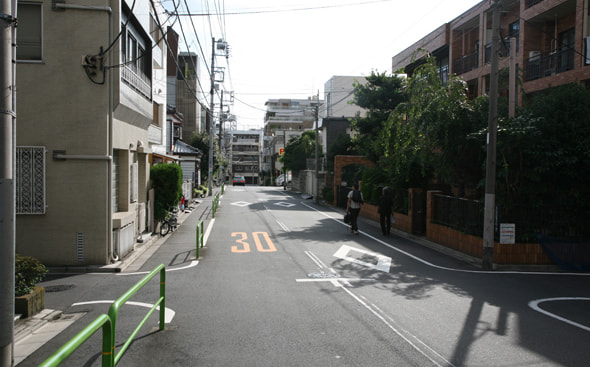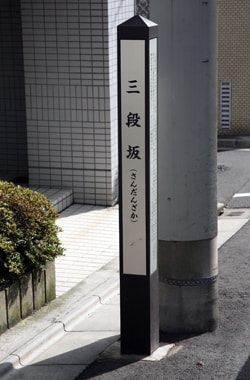
The Yanaka and Uenosakuragi areas have many slopes leading to the Ueno plateau that forms the hill of Ueno. When one ascends and descends slopes, new scenery appears one after the other.

Sandan slope descending from the back of Tokyo University of the Arts to Nezu
Q: Could you tell me about the present Yanaka and Uenosakuragi areas?
Asao: There are some galleries, but no art dealers. It is not a paying business, so they closed their business. This area is a residential quarter, in which many samurai houses once existed, so it is not an appropriate place to do business. Recently, a French confectionery in Uenosakuragi 2-chome and the area around Yanaka Ginza are always crowded with visitors, but the number of other traditional stores has been decreasing.
Q: What about atmospheres of communities and streets in Taito City, Yanaka and Uenosakuragi?
In the time of Eiichi Uchiyama, the former head of Taito City, grass-roots communities were formed. At that time, residents could not be active in a town assembly unless they became staff members of it, and there were many residents who wanted to be staff members but could not. So they made an effort to create a meeting ground where outsiders can also play active roles. I have also took part in the effort for nearly 30 years, helped conduct activities outside of the town assembly, and made much of interactions with children and elderly people.
Rows of houses in Yanaka and Uenosakuragi have hardly changed, but large houses became small, many apartment buildings were constructed, and most stores along Kototoi Street were closed. After the war, Japanese cracker shops, grocery stores, candy stores, soba restaurants, sushi restaurants, antique shops, eel restaurants and ice shops stood side by side until around 1965, but the population has dropped, leading to a decrease in sales. On the other hand, a variety of stores have recently opened near Yanaka Cemetery. This area changed from an old-fashioned temple town to a pure residential quarter. If "Uenosakuragi" is added to a place-name, the price of land began to rise. We paid the ground rent to Kan-eiji Temple until around 1949-50, but later we purchased the land from the temple. (continued in the upper right column)

Greenery can be seen all around the area.
Streets in this area have not changed. Although there was a plan to build a wide road running from the site around Kototoi Street to Tokyo University of the Arts, I made an objection to the plan because rows of houses in Yanaka are destroyed if the road is widened. About 10 years ago, there was also a plan to turn the Uenosakuragi Hall (Uenosakuragi 1-chome) into a parking lot. The community committee has control over the hall. Fudoka Tourindou adjacent to the hall is newer than our store, but old man and woman who came from the main store in the Kanasi Region died one after another, so a new person who came from the main store is now working there. Buildings have lined main streets. If the economic bubble did not burst, Yanaka might be further encroached. The Tokyo Metropolitan Government stated, "What is the best to do with the entire Yanaka area? If residents can decide wisely on the issue, the government does not widen streets, and leaves the present rows of houses as they are," but things do not go well because some people insist, saying, "What do you do with landowners' gains if streets are widened?" Housing improvement is also important, but I want to make much of communities while developing people.
Q: What about a local cultural heritage and activities to preserve it? Also, what about local cultures?
I think local residents are unexpectedly indifferent. They do not even know where Denchu Hiragushi's former residence is. Foreign people who visited or live in this area started saying that Yanaka and this area are good places.
Basically, cultures cannot be seen, so subjective points of view are brought in. So many men, so many opinions. However, it would be nice if a person who has a definite idea says, "This is the culture of Yanaka" or "The culture should be preserved in this way." Things can be decided along that line. However, now people have a follow-the-crowd mentality, and do not speak out their opinions. Somebody should take the lead. I think when the renovation work of Tokyo Metropolitan Art Museum in Ueno Park is completed, large-scale art exhibitions and shows will be held again because many painters and artists say, "Ueno is a good place. I want to return to Ueno."

Sandan slope descending from the back of Tokyo University of the Arts to Nezu






